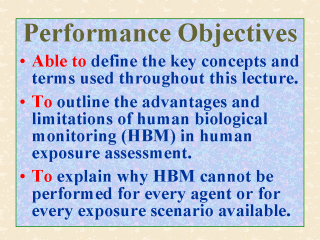| front |1 |2 |3 |4 |5 |6 |7 |8 |9 |10 |11 |12 |13 |14 |15 |16 |17 |18 |19 |20 |21 |review |
 |
At the end of
this lecture, students are expected to be able to distinguish the term exposure
assessment from exposure measurement. They should also be able to define the
key concepts or terms used throughout this lecture, such as human exposure, applied
dose, internal dose, biological monitoring, urinary recovery, urinary
creatinine levels, etc. With the materials presented in this lecture, students should be able to argue for or against the claim that epidemiologists generally have a superior role in performing human exposure assessment. Students are expected to be able to outline the advantages and the limitations of human biological monitoring, which is being used as a means of measuring (more) directly the internal dose of a chemical or biological agent accumulated in the human body. The internal dose is critical for evaluating the health risk at issue, in that an adverse effect is inducible by the total body burden of the toxin in the human body, not simply the dose from a single source or single route of exposure. To this date, it has been analytically and logistically impossible to quantify the internal dose for every chemical or for every exposure scenario available. Indirect measurement methods are hence needed and will be covered in the next lecture. Here in this lecture, students are expected to know why human biological monitoring cannot be performed for every agent or for every exposure scenario. |